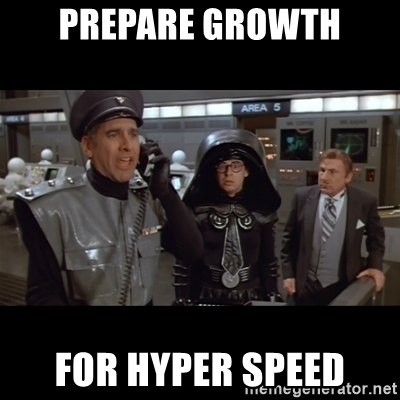
Hyper Growth At a Time of Uncertainty: Part 1

Most companies strive to manage periods of hypergrowth and when they’re in it, their goal is to remain there, riding those waves up as far as they possibly can. ‘Hyper growth’ is a term first coined by Alexander V. Izosimov. The World Economic Forum, taking it a step further, explained it as a company’s “need to have a compound annual growth rate (CAGR) of greater than 40%.”. However, for a more relaxed definition, one can understand it as being “a phase of rapid expansion that companies experience as they scale”. And what company isn’t looking to experience just that?
Times are ever-changing, and while we try and keep up with all that’s happening around us in the world today, it may seem odd to think about company growth. However, some companies will and do benefit from these global changes.

Two types of companies are likely to encounter hypergrowth during these times. The first are the awesome companies out there that are going into (or maintaining) hypergrowth irrespective of the world around them. They might not grow as fast as under these circumstances, but they may definitely find their way to hypergrowth. The second type of companies are those that help the world deal with the current circumstances. Those may be directly addressing the crisis, through tools such as telemedicine and advanced medical technologies, or supporting us throughout this crisis through online collaboration, eCommerce and delivery, and so on.
The Lucky Winners
This might seem odd to you, but looking back at the 2008 recession, there were quite a few companies that not only survived but thrived.
Who were these, you ask? Companies such as Lego, Groupon, Amazon, and Netflix (and more, but I’ll save you from reading through the long list). The most surprising among them were Lego and Groupon. Lego maintained hyper-growth due to its expansion into global markets. And Groupon? Fun fact: they only started the company in the midst of the economic downturn, but since their platform helped deal with current circumstances by giving consumers a way to save on most everything, they succeeded.
What’s still true: Business as Usual
While we find ourselves living in unprecedented times, experiencing the likes of which we only dreamed of in apocalypse movies, we still find that no matter the chaos outside, for some of us, it’s still business as usual in the office. And for hyper-growth companies, this means that many of the tried and true guidelines are still in effect:
- In order to ensure growth, you need Sales to continue to, well, sell. Focusing on sales enablement, aka aligning all aspects of your sales- the people, the programs, and the processes- will help you to maintain hyper-growth. Your sales team might just be your golden ticket to the chocolate factory, or in this case, to managing growth. It’s an upward spiral- the more they sell, the more you grow.
- Focus less on innovation. Yes, we can all agree that innovation is what propels you into the nether-sphere of success. And yet, when you are in hyper-growth, you are already doing something right. Focus more on what’s already there, than what might be there someday. Take fewer risks and instead work with what you know will succeed (see above, please) and keep some of that creativity on the back burner.
- Culture is an inevitable part of your company and is what will truly determine how your employees work when you are not there. As you are scaling up and giving up much of your direct influence, promoting the proper culture within your company is the only way to keep things going the way you envision them. Whether it be defining culture in clear observable terms or ensuring managers reinforce target behaviors, among others, will help maintain it while you continue to scale up.
- Empowerment is another key principle to keep your organization (over)achieving its goals as you scale. Make sure employees have full ownership over their tasks, the tools they need to carry them out, and the motivation to get it done. By empowering your people at the tip of the spear, they will take it and run with it, ensuring the growth of your company.
Growth Loops
As you are on a hyper-growth spurt, keep in mind that it isn’t never-ending. Whatever growth driver is pushing you forward, it will end someday, and so you have to think of growth loops. Growth loops refer to “a system that takes a growth indicator, processes it, outputs more of it, and then feeds this output back as input for the next loop cycle.” Or, as I like to think of it, make sure you have the next target in your sights.
To keep growing, you have to make sure to put another (significant) growth spurt in place before the one you are riding will die down. As each time you have grown more than the last time, each growth spurt also has to be bigger, making it quite a challenge.
In these times, however, it can be difficult to work in growth loops. In an unpredictable market, the next iteration of the loop is far more likely to be disrupted by changing circumstances, well beyond your control. Make sure to invest more time and effort into finding the next growth loop than you usually would. Check out more potential avenues for growth and try to have more than a single such initiative in place. The more alternative growth loops you’ll have in place before this one runs out, the better off you are.
As the world around you is going through a crisis, don’t try to plan too far ahead. Focus on short-term opportunities to avoid nasty surprises down the road. And try and align yourself with what’s going on outside – how are you uniquely positioned to help the world around you through these tough times? You’d be surprised at how impactful you can be to not just yourself and your fellow citizens but your own company.
Having the right people is important, but…
As any good manager can tell you, there is nothing more important than having the right people. In fact, it’s probably the most important thing in determining your success. When in hyper-growth, your ability to scale is often constrained by how fast you can hire them. While this is definitely true today, you might want to slow down hiring a bit compared to previous periods of hyper-growth, for a few main reasons:
- If you’re an ‘office first’ company, then you’re all about face-to-face communications. Whether it’s with hiring onboarding, going through this process remotely is quite a change. Give yourself time to adapt to the new reality (and consider being a remote company). Going into a hiring frenzy without changing some of your ways will often result in unfortunate hiring decisions and bad onboarding experiences.
- Capital is at a premium. You’re probably not going to be getting as much capital per equity over the next 12 months as past companies in your situation. Hiring new employees is probably the single most expensive route you can take and will have the longest-term impact on your burn rate. Staying lean is a priority today, to enable efficient use of capital and to keep you ready for unexpected surprises.
- Hiring processes take time to go into effect, starting from the initial decision to fill a specific role until ultimately finding and onboarding the right person. In low markets, it’s definitely easier to hire very good people but will still take time for the process to run its course. And as we discussed, in this rapidly changing market, the faster you move, the better.
While awesome people can’t ever be replaced, you should also check out some of the alternatives. Consider which tools and techniques you can employ to get the team you already have more productive (if you get a chance, check us out!). Look towards other options, such as using external agencies or buying off-the-shelf software. Depending on the problem you are trying to solve, you’ll often find those solutions to be more cost-effective, but even more importantly- especially today- they will deliver faster.
Don’t stop hiring people and aim to hire the best people you can get. But, don’t hire as aggressively as the textbooks say and focus on alternatives. Bring these all together and I’m sure you’ll be a lean, mean, growth machine in no time. 🙂





